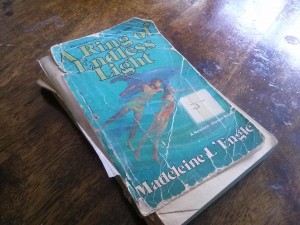“These fragments I have shored against my ruin”
T.S. Eliot, The Waste Land
I have a large single-volume encyclopedia in which I pressed assorted flowers and fall leaves over the years. My grandfather gave me the book, and it matters to me because it reminds me of who he was and what he wanted for me. It also matters because it holds these fragile traces, things of beauty that I long ago decided were worth preserving. The book is on a shelf in my bedroom, and I couldn’t tell you when I last turned to it for information, but it stands there, a sentinel of memory. Along with so many thin pages filled with knowledge, my relationship with a person who’s been dead fifteen years and my memories of fine fall days are bound up in this book. It is so much more than paper. It is so much more than words or information. It is memory in material form.
I heard a wonderful talk recently about books as “technologies of memory,” and the speaker showed fabulous images of nineteenth-century books in which readers had left traces of themselves. They left behind flowers, locks of hair, newspaper clippings, letters, and pictures. They also left behind their thoughts and feelings in notes they scribbled in margins or inside the cover. Like my encyclopedia, these books hold on to these people and preserve their memories. In many cases, the people themselves are long forgotten, but the traces they planted in the pages blossom into memories that live on.
I have written in lots of books over the years. The notes I’ve made, the passages I’ve underlined are a record of who I was when I read the book, and if I’ve re-read the book, and written in it with each reading, then the book becomes an archaeology of my reading self. Asterisks that I put in Jane Eyre when I was 18 share the margin with asterisks from when I was 22 and from the first time I taught the book many years after that. The pages of that book hold Jane and Brontë and multiple iterations of me. It is a sort of core sample that measures many years of a reader (me) as well as the fictional character that lives her whole life in those pages and the long-dead author who crafted Jane and invited me to leave bits of myself scattered along the margins of Jane’s life.
Many of the books I’ve written in are on my shelves. In some cases, I have newer, cleaner editions, but I keep these old books because they remind me who I am. And all the books together are another measure of memory. Jane Eyre, and the encyclopedia, and countless other texts range over the shelves in my house and my office. Each one preserves traces of my becoming, and collectively they offer a measure of how I became who I am.
 I end with a photo of the copy of Madeleine L’Engle’s A Ring of Endless Light that I read and reread until it fell to pieces. I keep this book because it was important to me a long time ago, and that fact makes it important still. Sitting on my shelf, it joins with the many other books that measure my memories. Together, they shore up the fragments of my life and hold me together.
I end with a photo of the copy of Madeleine L’Engle’s A Ring of Endless Light that I read and reread until it fell to pieces. I keep this book because it was important to me a long time ago, and that fact makes it important still. Sitting on my shelf, it joins with the many other books that measure my memories. Together, they shore up the fragments of my life and hold me together.
